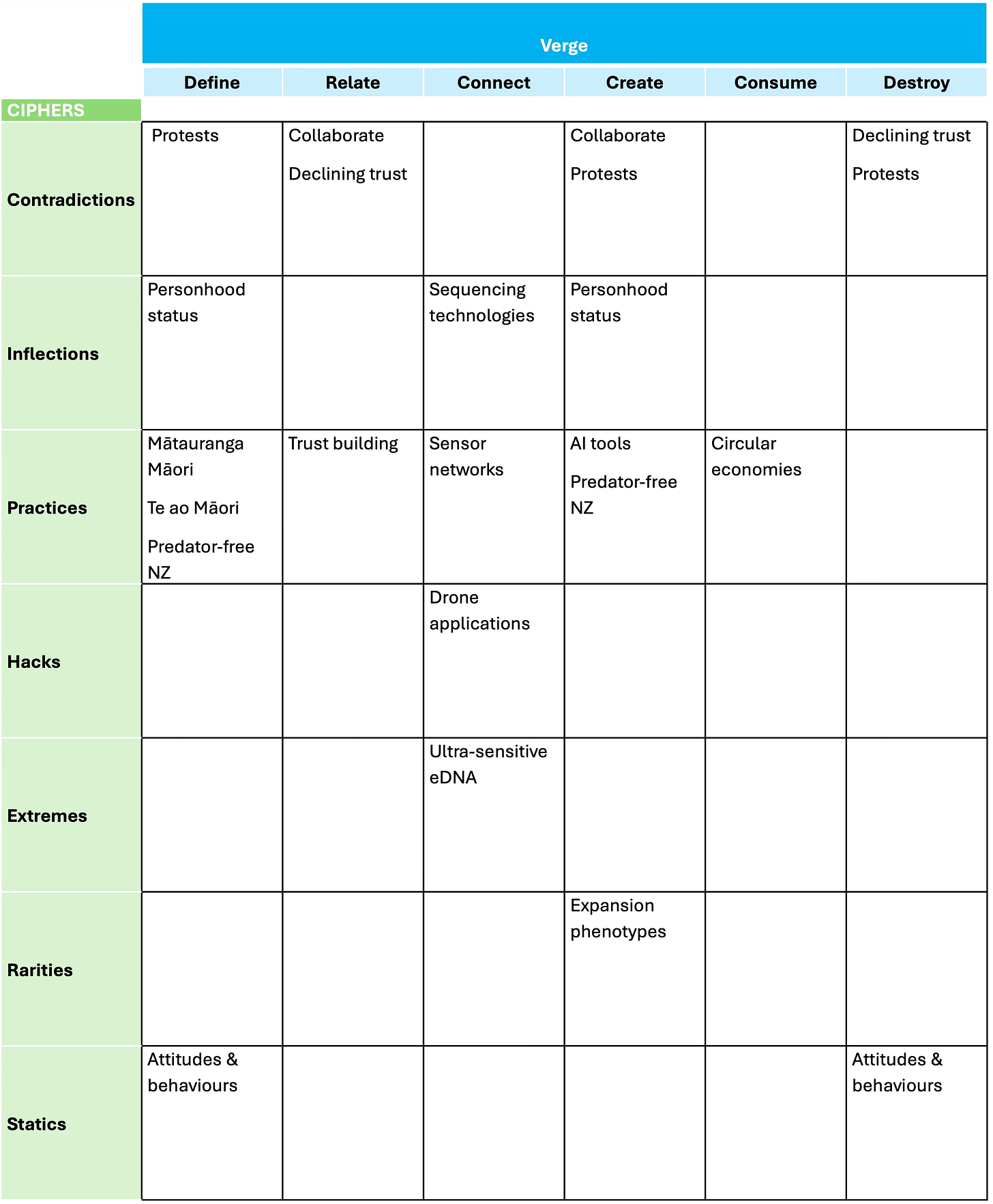Tips on scanning the environment
Good scanning is essential for futures, and other work. Make sure you use frameworks that facilitate sifting out the useful information for you.

Scanning the environment is a core task for any (futures) thinker. But it is very easy to get overwhelmed by the amount of information out there, and to disappear too long down rabbit holes chasing mad information threads.
Generative artificial intelligence can help you get started by identifying general themes for a topic. For example, asking “what are the key technology trends influencing biosecurity?” can provide a useful starting framework but aren’t usually much help by themselves in tracking emerging developments. Other AI tools are, though, being used to collect and analyse data for futures and strategy projects. Futurists are quick to point out that these can be useful tools to help rather than replace them. But of course, they would say that.
A risk with using AI as an undirected data miner is that you relinquish critical thinking to an algorithm, replacing it with the hope that something useful pops out of large data sets. Past experience has shown that this is unlikely to provide useful insights.
Scanning involves sifting and filtering information. So, to be of value for your specific needs you must get into the details yourself, and to have precise rather than general questions to direct the scanning.
For example, I’ve just finished a technology scan for a biosecurity-focused organisation and used several questions to guide data collection and interpretation. Rather than apply just a general question like “what is the future of biosecurity for animal diseases?” I used questions about new diagnostic tools for disease detection in the environment and in host animals, the state of technological maturity, and whether they have already been applied to infectious diseases similar to the disease of interest, and their potential utility to be applied here in the next decade.
Scanning also needs to avoid looking for information that just supports a pre-determined position or scenario. And to be aware if you are giving too much, or too little, weight to a social, environmental, political or technological novelty.
Scanning frameworks
There are several frameworks or methods to help direct and organise scanning activity. They can be used for one-off exercises or as part of a regular cycle of scanning.
The STEEP (social, technological, economic, environmental, and political) and PESTLE (including legal as a separate sixth category) frameworks are commonly used in futures studies. Other categories are also available. They are just reminders that your scanning needs to be broad.
While these can give an impression of objectiveness and completeness, drawing insights from them requires much more work. It is not uncommon to see just a set of bullet points, or short paragraphs that summarise observations in each category, with the interrelationships between the categories and specific implications unexplored.
A couple of other frameworks, less well known outside of professional futures circles, can better help you find information that is going to be more useful.
CIPHER
Amy Webb at the Future Today Institute developed a different set of categories that help direct scanning attention, particularly when looking at technologies. She used the acronym CIPHER to capture these:
Contradictions – opposing or incongruous forces or developments
Inflections – major turning points or new paradigms
Practices – emerging behaviours, rules, and actions
Hacks – unusual or unintended uses of tools, technologies & systems
Extremes – technologies, functions, or concepts pushed to their limits
Rarities – highly unlikely or unexpected events or phenomena
What’s left out of this, and several other scanning approaches, is capturing what’s not changing. The future isn’t a greenfield site. The new must work, for better or worse, with or against some existing practices and mindsets (as the Three Horizons and some other methods emphasise).
Call this factor Statics, to get CIPHERS.
Verge
Another scanning approach is the Verge framework (also known as the “ethnographic futures framework”). This has six domains which prompt you to look for developments, events, or trends that could affect how people experience the world. For example, how would “x” (not the formerly known as Twitter “X”) affect how we relate to each other?
So, it differs from the CIPHER framework by focussing on potential implications rather than just identifying interesting things like CIPHERS. The six Verge domains are:
Define – concepts, ideas & paradigms we use to define world
Relate – social structures & relationships
Connect – technologies used to connect people, places & things
Create – processes & technologies through which we create goods & services (& meaning)
Consume – processes & technologies through which we consume goods & services
Destroy – ways in which we destroy value, and the reasons why
As one of the developers of the framework noted, these don’t need to be unalterable categories – they can be adapted to fit the issue and needs of a project and its participants. For example, “Control” may be a better category than “Destroy” in some cases.
As with the CIPHERS framework, how you categorise an observation can be less important than making sure it is included somewhere.
Biosecurity-related CIPHERS
Staying with the biosecurity topic, Hulme et al. published a paper last year that considered emerging advances in biosecurity especially in regard to a integrated “One Biosecurity” approach to improving the health of humans, animals, plants and ecosystems. That provided a high-level scan of developments, identifying four themes:
New surveillance technologies and their connection into an Internet of Things,
Handheld molecular and genomic tracing tools,
Incorporation of wellbeing and diverse human values into biosecurity decision-making, and
More sophisticated data analyses and modelling.
How could we apply CIPHERS to keep up with developments that drive, constrain or challenge these themes? Illustrative examples are shown below rather than being a detailed exploration. Those more closely involved with biosecurity can often be better placed to identify some significant relevant examples, but having an external perspective or being able to stand back to take a mor expansive view helps identify fringe or adjacent matters of potential relevance.
Contradictions:
The increasing focus of collaboration and values for biosecurity alongside the more general declining public trust in institutions. Could the latter adversely affect the former, or can the former help maintain or restore trust in the latter?
There is a rise in support for authoritarian and populist regimes in many parts of the world, while support for more progressive policies can be strong.
Inflections:
Whole genome and next generation sequencing have revolutionised many fields and are slowly gathering applications in biosecurity, especially since the SARS-CoV-2 pandemic.
Practices:
The incorporation of Mātauranga Māori & te ao Māori into biosecurity.
Use of sensor networks to monitor farms and/or wildlife.
Use of artificial intelligence to predict infection risks in livestock.
Hacks:
It can take quite a bit of searching to find a good hack, but a good place to look is where new technologies are being quickly adopted, such as unmanned aerial vehicles (“drones”). Some uses can be considered “hacks”. For example, the “SnotBot” which collects mucus samples from whale exhalations to assess whale and environmental health. In Hawaii drones are dropping citric acid on invasive coqui frogs to eradicate them in difficult terrain.
An interesting, non-biosecurity, hack is using an electric drill to power a bike.
Extremes:
Environmental DNA (and eRNA) are increasingly used to detect the presence of species in the environment but may not detect rare species or strains. However, CRISPR -based systems are now allowing ultra-sensitive detection of rare species from environmental samples.
Rarities:
By their nature these are hard to find. One biosecurity example is that the phenotypes of cane toads at the leading edge of range expansions in Australia. These increase dispersal rate but may also reduce reproductive rate, which creates potential new control strategies.
Statics:
Peoples’ attitudes and behaviours can inhibit or disrupt biosecurity programmes.
Farmers in some European countries protesting the removal of subsidies and/or new environmental regulations, and opposition to new climate change regulations from some farming groups in New Zealand, Illustrate resistance to change.
Biosecurity-related Verge
Looking at biosecurity through the Verge framework this can better help stimulate discussions about broader implications.
Define:
Mātauranga Māori & Te ao Māori complementing western science approaches, highlight changes in how we identify and look at problems and opportunities.
“Personhood” status given to physical features (such as rivers & mountains), and animal species (such as great apes & whales) illustrate changing values and worldviews.
Relate:
The increasing need to take long-term perspectives means that tactical command and control reactivity is becoming less helpful. For example, the necessity of investing in time and effort to build trust with new groups before engaging on specific biosecurity responses is being recognised.
Connect:
Combining AI-enabled cameras and satellites to remotely and automatically detect pests or diseases is a major biosecurity and conservation trend.
Create:
Diverse community involvement is now common in predator-free projects, although many projects have precarious financial support.
Trials of generative AI to support tasks undertaken by some employees are increasing, such as improving speed and quality of work in ACC . How can, or should, this be adopted for biosecurity programmes?
Consume
How could a slow shift in New Zealand towards more circular bioeconomies, and more rapid adoption elsewhere, affect biosecurity preparedness and responses?
Destroy:
Significant job cuts in government agencies and more constrained public funding are likely to adversely affect some biosecurity efforts and policy.
Over the last 20 years protests have been increasing around the world. These protests cover a variety of issues, but political, economic and environmental protests have been major themes. For example, changing subsidies and incentives in agriculture.
Declining trust in institutions may undermine collective actions.
Combining frameworks
There is no perfect scanning framework, and there can be value by combining them. For example, a contradiction picked up by CIPHERS can have relevance for the Define, Relate, Create and Destroy categories of Verge (see Table below). Protests, for example, can help redefine values, lead to creating new approaches, as well as undermining progress.
Combinations can help stimulate deeper discussions, as well as direct further scanning to fill in more of the blank cells.


